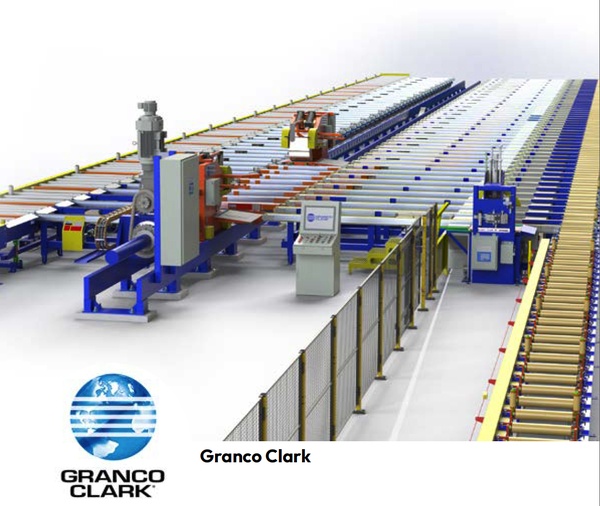Posted by: Scott Biggs 4 months ago

AL Circle:
Granco Clark plays a pivotal role in the aluminium extrusion sector with its cutting-edge equipment solutions.
Based on your industry insights and customer demand data, how do you foresee the global aluminium extrusion market evolving in 2025 and the next five years? Which sectors (e.g., automotive, construction, renewable energy) are driving the highest growth in extrusion demand?
Granco Clark:
Global Aluminium Extrusion Market Evolution - Current economic conditions, bothnational and global, significantly complicate this issue. Assuming we achieve a stable tariff and solidify fair trade agreements, we would expect:
The global aluminium extrusion market is likely to continue its growth trajectory, driven by increasing demand across various sectors. Multiple factors will contribute to this:
Sustainability: Aluminium’s recyclability and lightweight properties align well withglobal sustainability initiatives, making it an attractive material.
Infrastructure Development: Ongoing and planned infrastructure projects worldwide, particularly in developing economies, will require significant amounts of extruded aluminium for construction, transportation, and power transmission.
Electric Vehicle (EV) Adoption: The rapid growth of the EV market is a significant driver, as aluminium is crucial for lightweighting vehicles to improve efficiency and range. (The I.C.E.-based vehicle market also focuses on lightweighting and impact absorption possible with aluminium extrusions.)
Renewable Energy Expansion: Solar panel frames and structural components in wind turbines utilise aluminium extrusions. The growth of renewable energy will fuel demand.
Based on current trends, we anticipate the following sectors will be key drivers of growth in aluminium extrusion demand:
Automotive: Lightweighting for fuel efficiency and the structural components of electric vehicles (EVs) will be a major growth area.
Construction: Demand for aluminium in windows, doors, facades, and structural elements will remain strong, with a potential increase in sustainable building practices.
Renewable energy: The expansion of solar and wind power will significantly increase the need for aluminium components.
Transportation (non- automotive): Rail, aerospace, and marine applications will also contribute.
Reshoring due to aggressive tariff policies could play a significant role in creating demand within the U.S.
AL Circle:
In which key industry sectors are 6000-series and 7000-series high- strength aluminium alloys predominantly utilised, and what specificchallenges do their extrusion and heat treatment processes present in terms of production efficiency, material properties, and technological advancements? How has Granco Clark adapted its technology to ensureprecision, reduced energy costs, and enhanced mechanical properties?
Granco Clark:
Predominant utilisation and challenges: 6000 Series: Widely used in construction (windows, doors, architectural profiles), transportation (automotive structural parts, railcars), industrial applications (machinery frames, ladders),and consumer goods.
Challenges in extrusion include achieving complex profiles with a good surface finish and managing distortion during the quenching process.
7000 Series: Primarily used in applications requiring remarkably high strength-to-weight ratios, such as aerospace (aircraft structures), high-performance automotive (chassis components, suspension parts), military applications, and some sporting goods. Extrusion of 7000 series alloys is more challenging due to their higher strength and lower extrudability, requiring higher pressures and temperatures. Quenching and heat treatment are critical in achieving the desired mechanical properties. This alloy can be sensitive to processing parameters, which can affect its strength, corrosion resistance, and fatigue life.
Granco Clark’s Innovation: To address these challenges, Granco Clark focuses on:
Precise Heat Treatment Systems: Offering advanced furnaces and quenching systems with accurate temperature and timing controls to ensure optimal mechanical properties while minimising energy consumption.
Automation and Control Systems: Implementing sophisticated control systems to ensure consistent and repeatable processing, reducing variability, and improving efficiency.
Development of traceability allowing “point in time” data mining to validate critical processes or performance concerns.
Development of tools not currently available, allowing us to verify critical processes in line with the extrusion process.
AL Circle:
Scrap generation is a major cost concern in extrusion operations. How do Granco Clark’s solutions help customers minimise billet scrap, optimise metal recovery, and improve die life? Could you provide specific case studies or metrics demonstrating measurable yield and cost savings improvements?
Granco Clark:
Granco Clark’s solutions incorporate features such as:
Precise Billet Cutting and Handling Systems: Minimising end cuts and ensuring accurate billet lengths using thinkerf technology reduces material waste, marking the beginning of the process. Utilising our recipe data loading for production runs while incorporating feedback from the press and handling allows us to optimise billet lengths for each order.
FusionBond capability: Adding the Granco Clark patented FusionBond system to the already accurate billet sawing system virtually eliminates any pre-press billet/log scrap by utilising the entire log length for every log.
Isothermal/Isopressure extrusion: With the addition of a Granco Clark Taper Quench, extruders can take advantage of longer billets while increasing average ram speeds by an average of 15 per cent per die, especially when tapering is used in conjunction with solutionising on every billet. This results in even die facepressures and consistent extrudate temperatures throughout the press life cycle.
Efficient scrap handling and recycling systems: Solutions for the efficient collection, segregation, and return of extrusion scrap to the melting process.
The following KPIs should be considered:
Reduced percentage of billet scrap per unit of extruded product.
Increased metal yield (ratio of input billet weight to output extruded product weight).
Extended die life (number of cycles or tons of aluminium extruded per die).
Increased billet lengths to the press to allow for maximum extruded product per discarded butt. This is achieved utilising precise heating, solutionizing, and tapering of the billet to be extruded.
AL Circle:
Downtime in extrusion operations can be extremely costly. How does Granco Clark integrate real-time data monitoring, predictive maintenance, and AI-driven diagnostics into its systems to enhance equipment reliability and minimize unplanned shutdowns? Could you share real-world data demonstrating downtime reduction and maintenance cost savings?
Granco Clark:
Granco Clark integrates the following:
Real-time sensor data and monitoring systems: Providing operators with live data on critical parameters like temperature, pressure, vibration, and energy consumption.
Predictive maintenance algorithms: Analysing historical and real-time data to identify potential equipment failures before they occur, allowing for pre-emptive maintenance scheduling.
AI-driven diagnostics: Utilising AI to analyse complex patterns in equipment data to diagnose issues quickly and provide insights into root causes.
Remote monitoring and support capabilities: Enabling remote access for diagnostics and troubleshooting by Granco Clark’s service and engineering teams.
User-friendly interfaces and Maintenance Scheduling Tools make it easier for customers to monitor equipment health and plan maintenance activities.
By utilising our custom SCS4.0 software (Industry 4.0), there will be a significant reduction in unplanned downtime (measured in hours or percentage). This will also result in lower maintenance costs due to pre-failure interventions and reduced emergency repairs. The goal is to increase the overall equipment effectiveness (OEE).
AL Circle:
Dynamic shifts in production, recycling rates, and end-use demand across key industries shape the global aluminium billet market. Based on the latest market data, what is the estimated global annual production and consumption of aluminium billets? What percentage of this comes from secondary (recycled) aluminium versus primary aluminium? Considering the increasing push for sustainability and circular economy initiatives, how do you see this ratio evolving over the next five years?
Granco Clark:
Considering Granco Clark’s position in the lifecycle of aluminium, this question can be challenging for us to answer. However, we foresee an increase in demand for both primary and secondary aluminium extruded products. We have seen a significant increase in demand for casthouse equipment and solutions that support this perspective. Such solutions comprise log handling, log sawing, billet sawing, robotic billet stacking and palletising, bundle banding, and billet marking via laser or other conventional means.
Additional comments:
Estimated global annual production and consumption: Based on recent market reports, the global annual production and consumption of aluminium billets are substantial, likely in the tens of millions of tonnes. However, specific figures fluctuate based on economic conditions and industry demand. (Based on recent market research reports from reputable sources.)
Percentage of secondary vs. primary aluminium:
The percentage of secondary (recycled) aluminium used in billet production is significant and growing due to increasing awareness of sustainability and the energy savings associated with recycling. Globally, it could be in the range of 30-50 per cent, but this varies significantly by region and application.
Evolution over the next five years:
The ratio of secondary to primary aluminium in billet production is expected to increase over the next five years. This will be driven by a continued emphasis on government regulations and industry initiatives promoting recycling and resource efficiency.
Technological advancements in recycling include improvements in sorting, melting, and refining technologies that allow for higher quality recycled aluminum.
In many cases, recycled aluminium is more energy-efficient and cost-effective to produce than primary aluminium.
This is bolstered by end-users increasingly demanding products made with recycled materials.
AL Circle:
What is the estimated global annual demand and consumption of extruded aluminum products? Which regions are currently the largest consumers, and what factors (such as infrastructure growth, EV adoption, or sustainability policies) are driving demand in these markets? How do you see regional consumption patterns evolving over the next five years?
Granco Clark:
The global demand and consumption of extruded aluminium products are substantial, expected in the tens of millions of tonnes annually. Refer again to recent market research for timely and precise figures. Currently, the largest consuming regions include Asia (particularly China), which is driven by rapid infrastructure development, industrialisation, and increasing automotive production. North America continues with strong demand from the automotive, construction, and aerospace sectors. EV Adoption continues to increase demand for lightweight aluminium components in electric vehicles. (This is true for traditional I.C.E. vehicles also.)
AL Circle:
What are the next major technological breakthroughs that Granco Clark is working on to redefine aluminium extrusion in the coming decade? How do you see your R&D investments aligning with the evolving requirements of sustainability, lightweighting, and high-strength aluminium applications?
Granco Clark:
Potential areas of focus for Granco Clark include the following:
Smarter and more autonomous extrusion lines: Integrating advanced sensors, AI, and robotics for self-optimising processes, reduced manual intervention, and improved quality control. This will reduce workforce requirements while improving process efficiency and accuracy.
Energy-efficient extrusion technologies: Innovations aimed at significantly reducing energy consumption during billet heating, extrusion, and cooling processes. This could involve new heating methods, press designs, and heat recovery systems.
Enhanced material handling and automation: Solutions for more efficient and safer handling of billets and extruded profiles.
Digital twins and simulation: Creating virtual representations of extrusion processes for better design, optimisation, and predictive maintenance.
Sustainable extrusion practices: Technologies that minimise waste, reduce emissions, and facilitate the use of higher percentages of recycled aluminium.
Share on Twitter Share on Facebook